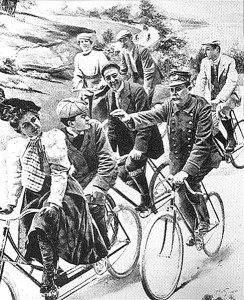Since 1956, the League of American Bicyclists, with the support of bicycle organizations throughout the United States, has proclaimed May as National Bike Month. It’s interesting to consider the impact bicycling has had on our culture.
 In the late 1800s, times were undergoing tremendous change. Inventions such as the telephone and the light bulb were poised to radically change America. Mechanized farming was revolutionizing agriculture. It’s noteworthy that even with these modern inventions, 51% of all patent applications in 1899 were bicycle related – 49% were EVERYTHING ELSE combined. This is not surprising considering the importance transportation has in our culture. Some of the first automobile manufacturers, such as Ford, Rover, and Mercedes-Benz, started out with bicycles – the automobile was still years away. And these early bikes rolled on tires made by Dunlop and Michelin. The bicycle was the mother of inventions such as pneumatic tires, statistical quality control, alloying of metals for light weight and strength, road maps, driver’s licenses, vehicle insurance, and sadly, planned obsolescence and even “chop shops”. Bicycle advertisements featured attractive models posing with the latest products. There were bicycle ambulances, bicycle postmen, and even bicycle traffic cops (often ex-bicycle racers) who would chase down and ticket “scorchers” – what we now refer to as “speeders”. The inventors of the era’s high-technology, the “aero plane”, were bicycle manufacturers Orville & Wilbur Wright. In fact, Orville was a former bike racer himself! The bicycle was as influential in the 1890s as the personal computer was in the 1990s
In the late 1800s, times were undergoing tremendous change. Inventions such as the telephone and the light bulb were poised to radically change America. Mechanized farming was revolutionizing agriculture. It’s noteworthy that even with these modern inventions, 51% of all patent applications in 1899 were bicycle related – 49% were EVERYTHING ELSE combined. This is not surprising considering the importance transportation has in our culture. Some of the first automobile manufacturers, such as Ford, Rover, and Mercedes-Benz, started out with bicycles – the automobile was still years away. And these early bikes rolled on tires made by Dunlop and Michelin. The bicycle was the mother of inventions such as pneumatic tires, statistical quality control, alloying of metals for light weight and strength, road maps, driver’s licenses, vehicle insurance, and sadly, planned obsolescence and even “chop shops”. Bicycle advertisements featured attractive models posing with the latest products. There were bicycle ambulances, bicycle postmen, and even bicycle traffic cops (often ex-bicycle racers) who would chase down and ticket “scorchers” – what we now refer to as “speeders”. The inventors of the era’s high-technology, the “aero plane”, were bicycle manufacturers Orville & Wilbur Wright. In fact, Orville was a former bike racer himself! The bicycle was as influential in the 1890s as the personal computer was in the 1990sBecause it was impossible to ride a bicycle wearing traditional long dresses, female cyclists adopted “rational dress” – pantaloons which exposed the ankle. Women were arrested, which led many women to re-think their place in society: “Why can’t WE wear pants, work like men, and vote?” Susan B. Anthony said, “I stand and rejoice every time I see a woman ride by on a Wheel. The picture of free, untrammeled womanhood!” This new “freedom machine” was important in the struggle for women’s rights. On Sundays, cyclists who worked the standard six-day work week opted for all-day bike rides, foregoing church services. Noting a significant drop in attendance, some churches embraced the bicycle, offering outdoor services and valet parking. Others decried the invention. On a Sunday morning in 1896 a Baltimore preacher thundered from his pulpit: “These bladder-wheeled bicycles are diabolical devices of the Demon of Darkness. They are contrivances to trap the feet of the unwary and skin the nose of the innocent. They are full of guile and deceit. When you think you have broken one to ride and subdued its wild and Satanic nature, behold it bucketh you off in the road and teareth a Great Hole in your pants! Look not on the bike when it bloweth upon its wheels, for at last it bucketh like a bronco and hurteth like thunder. Who has skinned legs? Who has a bloody nose? Who has ripped breeches? They that dally along with the Bicycle!” Yes, the bicycle was definitely an engine for social change.
Often, when I’m teaching bicycle safety classes, students will ask me, “Don’t bikes follow the same rules as cars?” The unexpected answer is, “Well, sort of. Actually, cars follow the same rules as bikes.” Traffic law and principles underwent an important period of rapid development and refinement from the 1880s into the early 1900s as the roads were inundated with scores of cyclists. These thousands of new roadway users needed a body of regulations to reduce accidents and smooth traffic flow. They also demanded better roads. The Good Roads Movement took off in the United States beginning in May, 1880. Advocates for improved roads led by bicyclists turned local agitation into a national political movement. In the early 1900s, when the automobile began production, this body of traffic laws and transportation infrastructure was quickly co-opted by motorists. If you appreciate having a place to drive your car, and to do so safely, you owe a debt to the humble bicycle.
Also see related post: Bicycle Riders as Disciples-of Progress.
Also see related post: Bicycle Riders as Disciples-of Progress.
Randy Victory, Cottonwood
League of American Bicyclists Cycling Instructor
Board Member, Verde Valley Cyclists Coalition

How Bikes Saved America’s Roads: A Historical Perspective
That link is dead — try archive.org
“This is an adapted excerpt from “The King’s Best Highway: The Lost History of the Boston Post Road, the Route That Made America,” by Eric Jaffe, which hits bookstores today.”.